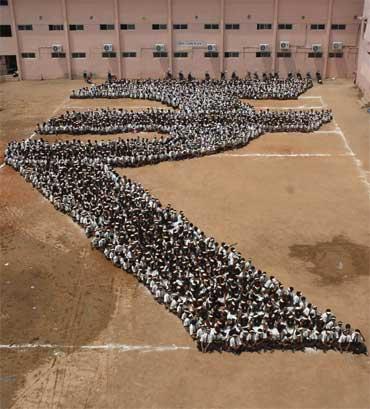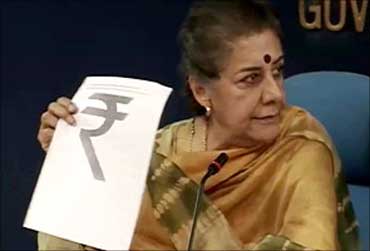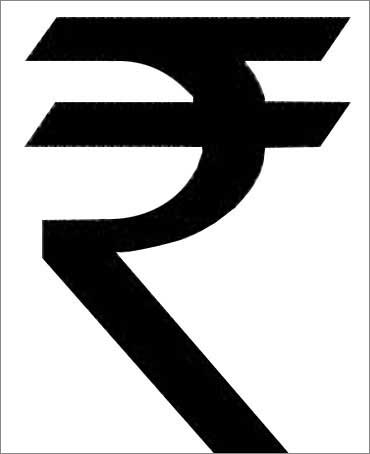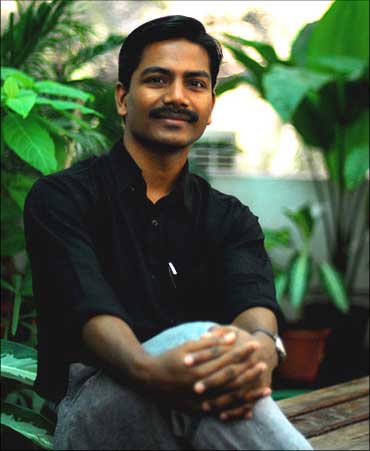 | « Back to article | Print this article |
The new rupee symbol deserves more respect
As one of the world's oldest currencies, the Indian rupee's new symbol deserved a more dignified debut, says Sanjaya Baru.
The Indian rupee's new symbol, an elegant, simple and brilliant combination of Sanskrit Ra and the English R without the stem, deserved a more dignified debut.
A minister holding up an A4-size sheet of paper for cameras sitting at her desk? No fancy unveiling, no fireworks or music, no celebrations at all? How unfortunate. How inelegant. How crass.
The Indian rupee, which is the original rupee, dates back centuries. Historians believe the name derives from the Sanskrit Rupyakam and date the use of silver rupee coins to 6th century BC.
The Indian rupee currency note of today carries the Sanskrit name Rupyakani. The minting of currency named "rupee", or "ruppayyah" is believed to date back to the reign of Sher Shah Suri (1486-1545).
This continuity perhaps enabled Pakistan to continue to call its currency post-Partition as the Pakistani rupee.
Click on NEXT to read more...
The new rupee symbol deserves more respect
Going beyond the sub-continent, the Indian rupee acquired the two most important characteristics of money - as a unit of exchange and a store of value - in a wide range of countries along the coast of East Africa, the Arab Gulf (presently the member countries of the Gulf Cooperation Council), the Indian Ocean island nations, the whole of the Indian sub-continent, and well into South-East Asia.
When a currency with such grand and proud history finds a renewal of life, as India becomes a trillion-dollar economy with rising shares of world trade and capital flows, the assignation of a new symbol is a momentous event that generations to come will remember.
Could someone in government or the Reserve Bank of India not have thought of a better way of unveiling the new rupee sign to the world?
Click on NEXT to read more...
The new rupee symbol deserves more respect
In a country that enjoys ceremony, pomp and circumstance, where symbols and symbolism matter, someone should have thought of a grand unveiling - perhaps near India Gate lawns - with the President of India declaring open a nicely designed large replica to television cameras.
Would it all have been making much of a muchness? Certainly not. Nothing is at once so personal and so public in the social life of a person than the unit of currency one deals with.
Next to language, it is our most important link with the world around us.
Which is often why politicians confuse the value of a currency with national pride.
During RBI Governor Bimal Jalan's term in office, he had sleepless nights dealing with a situation, after the Pokhran-II "Shakti" nuclear tests, when Sushma Swaraj declared that now that India was stronger, the rupee would become stronger too!
Click on NEXT to read more...
The new rupee symbol deserves more respect
An appreciating rupee was not what RBI wanted at the time. China has demonstrated the uses of under-valued currency for a nation seeking power.
A depreciating rupee is not necessarily a sign of a weakening economy. Rather, it could be the means of strengthening an economy's competitive position.
At any rate, patriotism can take a holiday if it pinches one's pocket. In 1998, Ms Swaraj had forgotten the lesson of 1991.
The first to take their money out of India at the time of the 1990-91 balance of payments crisis were, in fact, non-resident Indians, or such Indians who had put their money into NRI accounts.
As the rupee weakened, the flight of capital, triggered by panic among Indians, speeded up the outflow.
But India has come a long way from that time. While any currency, including the US dollar, can be threatened by a loss of confidence, the fact is that there is greater confidence in the Indian rupee today than at any time in recent history.
Click on NEXT to read more...
The new rupee symbol deserves more respect
Time was when the only places outside India where the rupee would be accepted were Nepal, Maldives, London's Southall and Mustafa's in Singapore!
From those glorious days of the "Empire" when the Indian rupee had takers all around the Indian Ocean littoral, the rupee saw its days of ignominy too.
As India's economy becomes bigger and more competitive, its currency too has acquired a new spring in its feet. The new symbol for the rupee is a symbol of this new confidence.
And so, how appropriate that the new design, combining the ancient and the modern in contemporary India - Sanskrit and English, the curve and the slash - should come from a bright young teacher, Udaya Kumar of Tamil Nadu?
I would not have celebrated the new design as much if it had come from some fancy designer in Paris, London or Rome. It is the earthiness and the Indian-ness of the designer that lend special meaning to the symbol.
Click on NEXT to read more...
The new rupee symbol deserves more respect
I am not surprised that the UK Guardian quotes some fancy London designer awarding Udaya Kumar a "B or a B plus" for what he calls an "unimaginative" design.
I am personally delighted RBI did not chase such fancy western designers and opted for Udaya Kumar's culturally rooted design.
In celebrating the rupee's new symbol, we must also celebrate Indian design. It is a pity that Indian design is not getting its due in a rapidly growing India.
Consider the importance that China and Japan have long attached to design. Even a small city-state like Singapore has two world-class design institutions, while students of design in India have to compete for a few dozen seats, after reservations are accounted for, at Ahmedabad's National Institute of Design, and a couple of private institutions.
Indeed, given this neglect of design as a discipline, despite India's rich cultural heritage, it is truly amazing that indigenous talent like that of Mr Kumar is still able to find expression and secure reward.
Mr Kumar is not a product of any fancy European design institute and yet he has come forward with an idea that will go down in history and make itself felt around the world.






